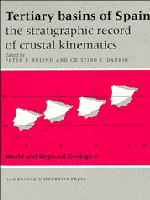Book contents
- Frontmatter
- Contents
- List of contributors
- Preface
- Dedication to Professor Oriol Riba IArderiu
- Memorial, Etienne Moissenet 1941–1994
- PART G GENERAL
- G1 Tertiary stages and ages, and some distinctive stratigraphic approaches
- G2 Cenozoic latitudes, positions and topography of the Iberian Peninsula
- G3 Tertiary tectonic framework of the Iberian Peninsula
- G4 Deep crustal expression of Tertiary basins in Spain
- G5 Oil and gas resources of the Tertiary basins of Spain
- G6 Mineral resources of the Tertiary deposits of Spain
- PART E EAST
- PART W WEST
- PART C CENTRE
- PART S SOUTH
- Index
G4 - Deep crustal expression of Tertiary basins in Spain
Published online by Cambridge University Press: 04 August 2010
- Frontmatter
- Contents
- List of contributors
- Preface
- Dedication to Professor Oriol Riba IArderiu
- Memorial, Etienne Moissenet 1941–1994
- PART G GENERAL
- G1 Tertiary stages and ages, and some distinctive stratigraphic approaches
- G2 Cenozoic latitudes, positions and topography of the Iberian Peninsula
- G3 Tertiary tectonic framework of the Iberian Peninsula
- G4 Deep crustal expression of Tertiary basins in Spain
- G5 Oil and gas resources of the Tertiary basins of Spain
- G6 Mineral resources of the Tertiary deposits of Spain
- PART E EAST
- PART W WEST
- PART C CENTRE
- PART S SOUTH
- Index
Summary
Abstract
The Variscan crust of the Iberian massif is 32–35 km thick, although this thins towards the Atlantic margin. To the north and south in the Pyrenees and Betics, the crustal structure is much more complex, but a crustal thickness of up to 50 km is well established in the Pyrenees. In the related foreland basins (Ebro and Guadalquivir) lithospheric flexing appears to have taken place without significant modification of the crust. The Neogene Valencia trough and Alboran basins formed by thinning of the crust, and minimum thicknesses of 15 km or less have been measured in each case.
Introduction
The shallow structure and stratigraphy of the Tertiary basins of Spain are relatively well known from industrial exploration and field geology. However, because sedimentary basins reflect deformation processes on a lithospheric scale, knowledge of the structure and mechanical properties of the lithosphere in which basins develop is essential for a complete understanding of basin evolution. Therefore, a brief introduction to lithospheric structure, which will be limited to the crust and uppermost mantle, in relation to Tertiary basins in Spain is presented.
The Tertiary basins of Spain (Fig. la) have generally formed by deformation of the Variscan (Hercynian) crust of the Iberian Massif. The crustal structure of Iberia has been extensively explored by seismic methods including refraction/wide-angle reflection and near-vertical deep reflection (Fig. lb). Consequently, the basement of the Tertiary basins in Spain, i.e., the crystalline crust of pre-basin formation, can be considered to be reasonably well known.
- Type
- Chapter
- Information
- Tertiary Basins of SpainThe Stratigraphic Record of Crustal Kinematics, pp. 15 - 19Publisher: Cambridge University PressPrint publication year: 1996
- 1
- Cited by



